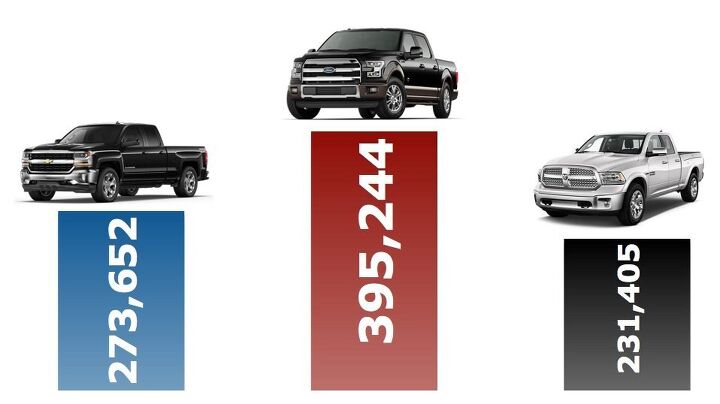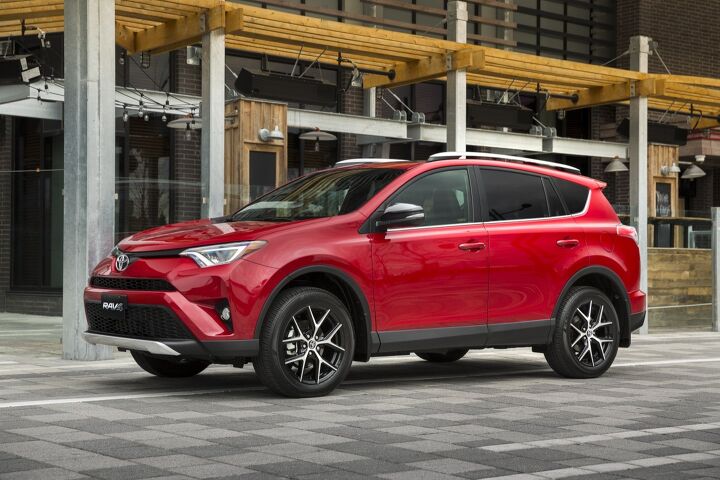Winning! These Are America's Best-Selling Cars, Trucks, SUVs, Vans, and Luxury Autos In 2016's First Half
We’ve reached the halfway marker. After new vehicle sales soared to record levels in calendar year 2015, the volume produced by automakers competing for market share in the United States continued to expand through the first six months of 2016.
Between January and June, the 30 most popular new vehicle nameplates in the United States generated half of all auto sales, leaving more than 250 other vehicles to fight over half the market. Many of those popular vehicles own a far greater chunk of the market than entire manufacturers. The top-selling Ford F-Series line of pickup trucks, for instance, outsells every auto brand aside from Toyota, Chevrolet, Nissan, Honda, Jeep, and Ford itself. The 30th-ranked vehicle, Subaru’s Outback, outsells whole mid-tier premium brands such as Cadillac, Infiniti, Lincoln, and Jaguar-Land Rover.
In other words, popular vehicles are very popular indeed.
These are the most popular of the popular, the podium finishers in five broad categories through the first half of 2016.
Chevrolet Silverado | -1% | 273,652
Ram P/U | +9% | 231,405
CARS
Honda Civic | +20% | 189,840
Toyota Corolla | -4% | 182,193
SUVs & CROSSOVERS
Honda CR-V | -2% | 159,075
Ford Escape | +6% | 155,378
VANS
Dodge Grand Caravan | +94% | 71,523
Toyota Sienna | -4% | 68,225
PREMIUM BRAND AUTOS
Mercedes-Benz C-Class | -14% | 37,305
BMW 3 Series | -23% | 32,976
[Images courtesy of automakers; graph by Timothy Cain]
Timothy Cain is the founder of GoodCarBadCar.net, which obsesses over the free and frequent publication of U.S. and Canadian auto sales figures. Follow on Twitter @goodcarbadcar and on Facebook.
More by Timothy Cain
Latest Car Reviews
Read moreLatest Product Reviews
Read moreRecent Comments
- El scotto They should be supping with a very, very long spoon.
- El scotto [list=1][*]Please make an EV that's not butt-ugly. Not Jaguar gorgeous but Buick handsome will do.[/*][*] For all the golf cart dudes: A Tesla S in Plaid mode will be the fastest ride you'll ever take.[/*][*]We have actual EV owners posting on here. Just calmly stated facts and real world experience. This always seems to bring out those who would argue math.[/*][/list=1]For some people an EV will never do, too far out in the country, taking trips where an EV will need recharged, etc. If you own a home and can charge overnight an EV makes perfect sense. You're refueling while you're sleeping.My condo association is allowing owners to install chargers. You have to pay all of the owners of the parking spaces the new electric service will cross. Suggested fee is 100$ and the one getting a charger pays all the legal and filing fees. I held out for a bottle of 30 year old single malt.Perhaps high end apartments will feature reserved parking spaces with chargers in the future. Until then non home owners are relying on public charge and one of my neighbors is in IT and he charges at work. It's call a perk.I don't see company owned delivery vehicles that are EV's. The USPS and the smiley boxes should be the 1st to do this. Nor are any of our mega car dealerships doing this and but of course advertising this fact.I think a great many of the EV haters haven't came to the self-actualization that no one really cares what you drive. I can respect and appreciate what you drive but if I was pushed to answer, no I really don't care what you drive. Before everyone goes into umbrage over my last sentence, I still like cars. Especially yours.I have heated tiles in my bathroom and my kitchen. The two places you're most likely to be barefoot. An EV may fall into to the one less thing to mess with for many people.Macallan for those who were wondering.
- EBFlex The way things look in the next 5-10 years no. There are no breakthroughs in battery technology coming, the charging infrastructure is essentially nonexistent, and the price of entry is still way too high.As soon as an EV can meet the bar set by ICE in range, refueling times, and price it will take off.
- Jalop1991 Way to bury the lead. "Toyota to offer two EVs in the states"!
- Jalop1991 I'm sorry, Dave. I'm afraid I can't do that.







































Comments
Join the conversation
So, between Ford's EcoBoost experience and its aluminum experience, now we know how the pickup market works. Pickup buyers howl and moan about any post-1960s technology before introduction, predicting it means The End for the manufacturer that introduces it. Then they avoid the first year of production while continuing to howl and moan. But when there are a few hundred thousand of the new-technology trucks in service, benefiting from the new technology, it starts seeming "normal" and the buyers come back.
Why bicycles are not included in article? It is now the preferred type of transportation in our area. You guys talk only about trucks. Whats so hot about them? I cannot get it.